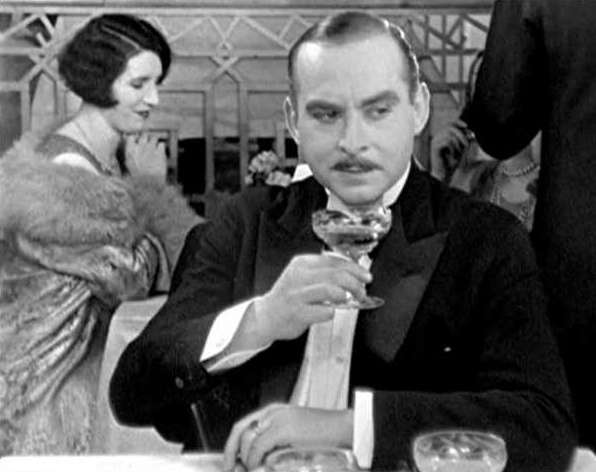The Hitchcock 9 - 7  FERDINAND VON ALTEN IN CHAMPAGNEChampagne (Aug. 1928) Champagne
FERDINAND VON ALTEN IN CHAMPAGNEChampagne (Aug. 1928) Champagne is a film slim in emotional content, but vibrant with the frivolity of the Jazz Age and tinged with a hint of the coming Great Depression. It's about a rich playgirl whose father decides to teach her a lesson while she's playing around abroad by pretending to have gone bankrupt. The story line is slight, but provides much opportunity for scenes of partying, dancing, drinking; of the interiors of a luxury liner and a big night club packed with people dancing; of a lively girl posing in a succession of gay frocks; and of dashing men in evening clothes. Gordon Harker, who played the glum-faced trainer in
The Ring and the eccentric, slapstick handyman in
The Farmer's Wife, shows his versatility by playing the millionaire father in
Champagne, where he looks somewhat like the car magnate, Henry Ford. The frizzy-haired Betty Balfour plays the spoiled heiress, and there are two other principals, the French actor Jean Bradin as "The Boy," her tall, impeccable boyfriend, and Ferdinand von Alten as "The Man," a mysterious mustachioed Hercule Poirot type who seems to haunt the girl wherever she goes.
The Girl makes headlines and starts the movie out with a bang by flying her father's private plane, Amelia Earhart-style, into the Atlantic to join up with the Cunard Line ship on which her boyfriend is traveling to France. She then announces she will "arrange" for her and The Boy to marry on board; but he balks at her tendency to take charge and steal all the attention, and they have a falling out. She winds up in Paris partying with a group of "interesting" new friends who no doubt enjoy the free-flowing liquor and champagne. Later her father comes to Paris and takes The Girl aside to tell her he has lost all his money. In response she goes to work as a flower girl in a vast restaurant-club-dance hall packed with diners and dancers and dominated by a big, mustachioed and cartoonish maitre-d'hotel, where sure enough The Man and later The Boy turn up.
The theme of
Champagne relates to those of
Downfall and
Easy Virtue, though the story is without their emotional depth and the consequences are less serious. The Girl isn't really a Bad Girl, though when we see her in the prolonged sequence giving a party for her "interesting new friends" in Paris, mixing a new cocktail she has invented, laughing, drinking, and trying on a succession of gaudy new frocks she has just bought, she seems pretty silly and superficial. When The Boy arrives and makes a disapproving comment about having always been taught that the best taste was the simplest, she goes back and puts on her dresser's severe black frock with round white collar. The Man is standing by as usual. Much of the time
Champagne seems like a movie in search of a plot. It's a series of situations and scenes, without much solid narrative content beyond the few basic premises. It tends to feel as empty as its giddy, frivolous protagonist.
The bubbly indeed is frequently pouring in
Champagne, but if it has some point to make it doesn't make it very forcefully and The Girl is not severely tested as are the protagonists of
Downfall and
Easy Virtue. This is more a chance for Betty Balfour to giggle and wiggle and pout and play It Girl, and for Jean Bradin to look aristocratic and impeccable in a succession of double-breasted suits.
Champagne posed the trickiest restoration troubles for the BFI Hitchcock 9 team. It was realized that what they were working from, though a negative, was a "second negative." So it turned out that while there was very good image quality, "there were some clumsily juxtaposed shots and framing errors, as well as the occasional shot exhibiting substandard acting or shots that were held uncomfortably long." "Second negative" meant that it was made up of "second-best shots, kept as a backup in case of damage to the original or for making additional prints for export," a practice they discovered with
The Ring. There were also no written records, production notes, scripts, or censors' intertitle lists to act as a guide as to how the original first negative was different. They were stuck with simply restoring the images they had. So the edit is "slightly compromised" due to the negative, but nonetheless "the result is a truly beautiful looking print that does full justice to Betty Balfour’s sparkling 1920s frocks," the
BFI notes say. Again the DVD of the BFI restoration has a special piano accompaniment.
Reviewed as part of the US premiere of The Hitchcock 9 BFI-restored silent films by the San Francisco Silent Film Festival, shown at the Castro Theater June 14-16, 2013. Screener DVDs provided by Larsen Associates.





